Affiliate disclosure: This post may contain affiliate links. Please see our Privacy Policy.
Seed storage is a problem for many gardeners, and few of us can contain ourselves when the new seed catalogs arrive each winter. This easy seed organizer will keep all your seed packets neat and tidy, so you know what you have in stock long before garden season arrives.
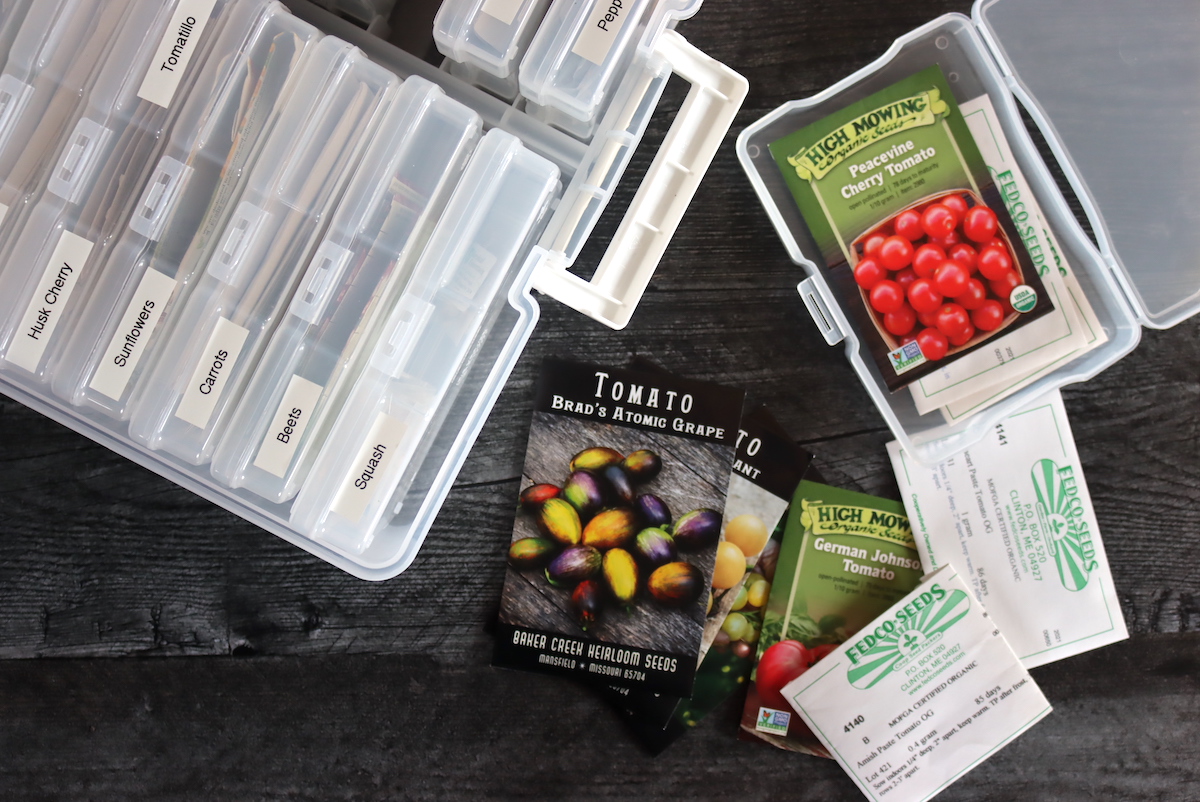
Every year, my husband and I sort through our garden seeds, taking stock of what we have and what we’ll need to order this year. We generally order from 3 or 4 different seed catalogs each winter, which keeps our extensive gardens diverse and fun.
The same conversation happens each year…
“Didn’t we have more watermelon seed? We couldn’t have planted it all last year…” *Shuffles through the bin of seed without finding it*
“I don’t know, but where’s the cherry tomato seed? Maybe we’re out?” *Pages through seed packets, gives up…and orders more*
Without a seed packet organizer, we end up ordering garden seeds that we already have again and again each year. It’s quite a bit of money down the drain, and with each extra order, our seed storage problem gets worse. There’s more and more seed to sort through, and worse yet, it’s all different ages.
I started organizing our seed packets into big manilla envelopes by type so that they’d at least be sorted. You can’t exactly see what you have, and you have to take each envelope out to see the label…but at least it was something.
Then finally, I came across this neat photo organizer at a local craft store. It was originally designed to organize standard-size photos (4”x6”, you know, back when we all actually took photos with cameras and then had them developed into prints.
It turns out, a photo organizer is a perfect size for organizing seed packets!
(I chose a photo organizer with 16 clear containers inside, but they also make photo organizers with rainbow-colored transparent containers if you want to get fancy. If for whatever reason plastic is not your thing, there are also a number of really creative handmade options on Etsy…if you’re trying to rock a cozy, cottagecore vibe. This utilitarian water-resistant transparent option is my choice though. I’m practical, not fancy…what can I say?)
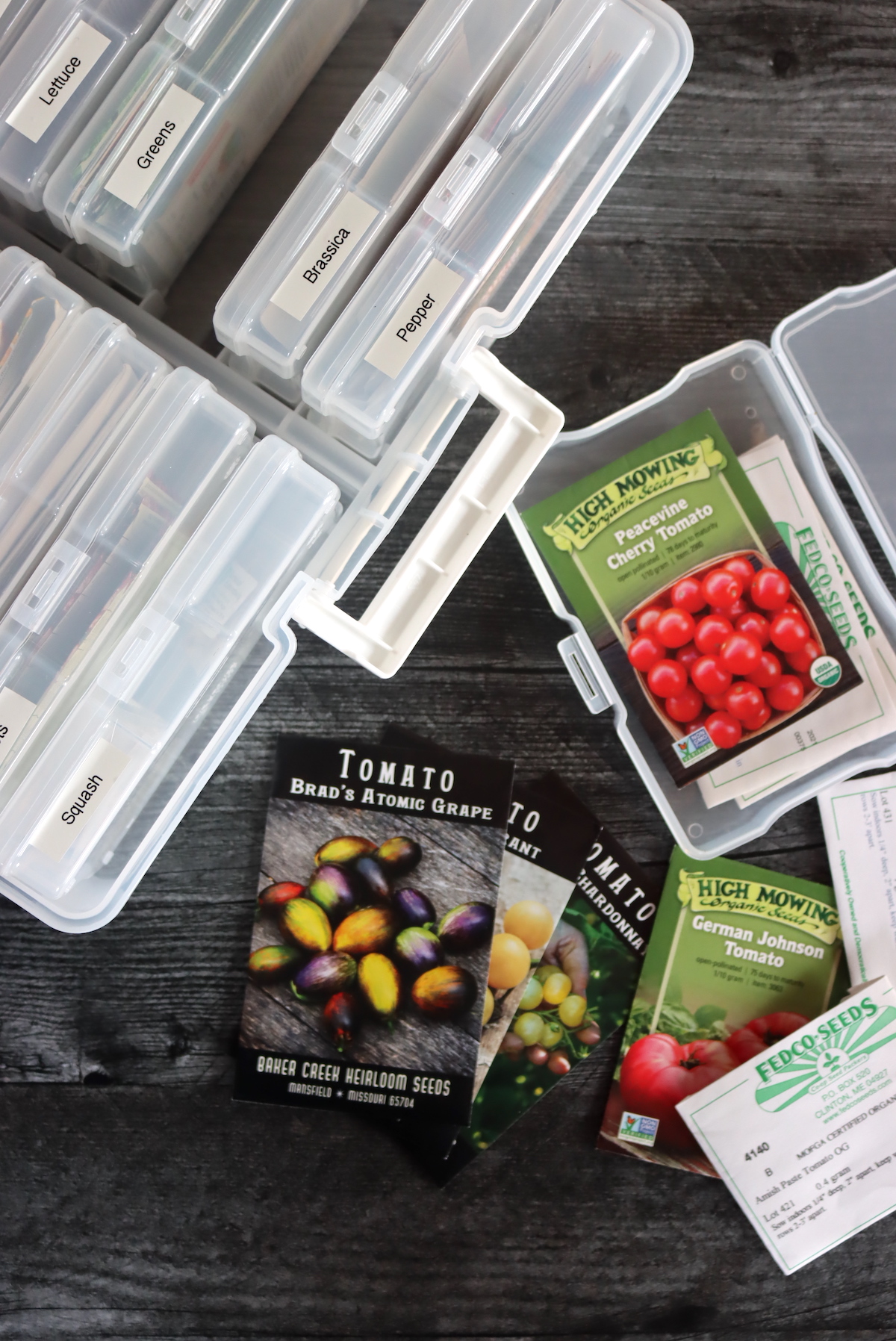
Standard-sized seed packets will all fit with a bit of extra room. Packets from places like:
- Burpee
- High Mowing Organic Seeds
- Fedco seeds
- Johnnys Selected Seeds
Some providers have larger seed packets, not necessarily because they’re more seed inside, but because they have truly stunning photos. Baker Creek Heirloom Seeds and Botanical Interests are two examples. They still fit just fine in a photo organizer.
I organize my seeds by type, each with its own labeled container. A standard portable photo organizer has 16 individual seed storage boxes, all contained in a larger box with a handle.
How you organize them is up to you, but I use a label maker to label each individual box clearly. (Masking tape and a sharpie would work just as well too.)
Here are my categories:
- Tomatoes
- Peppers (hot and sweet)
- Squash
- Basil & Eggplant (I always seem to plant them in the same bed anyway)
- Beets
- Carrots
- Cucumber
- Sunflower
- Tomatillos and Husk Cherries
- Edible Flowers as well as decorative ones
- Medicinal Herbs
- Melons
- Lettuce
- Other Greens (miner’s lettuce, mizuna, arugula, etc.)
- Brassicas (broccoli, cabbage, etc.)
- Other Unique Fruits (Litchi Tomatoes, Tamarillos, garden huckleberries, etc.)
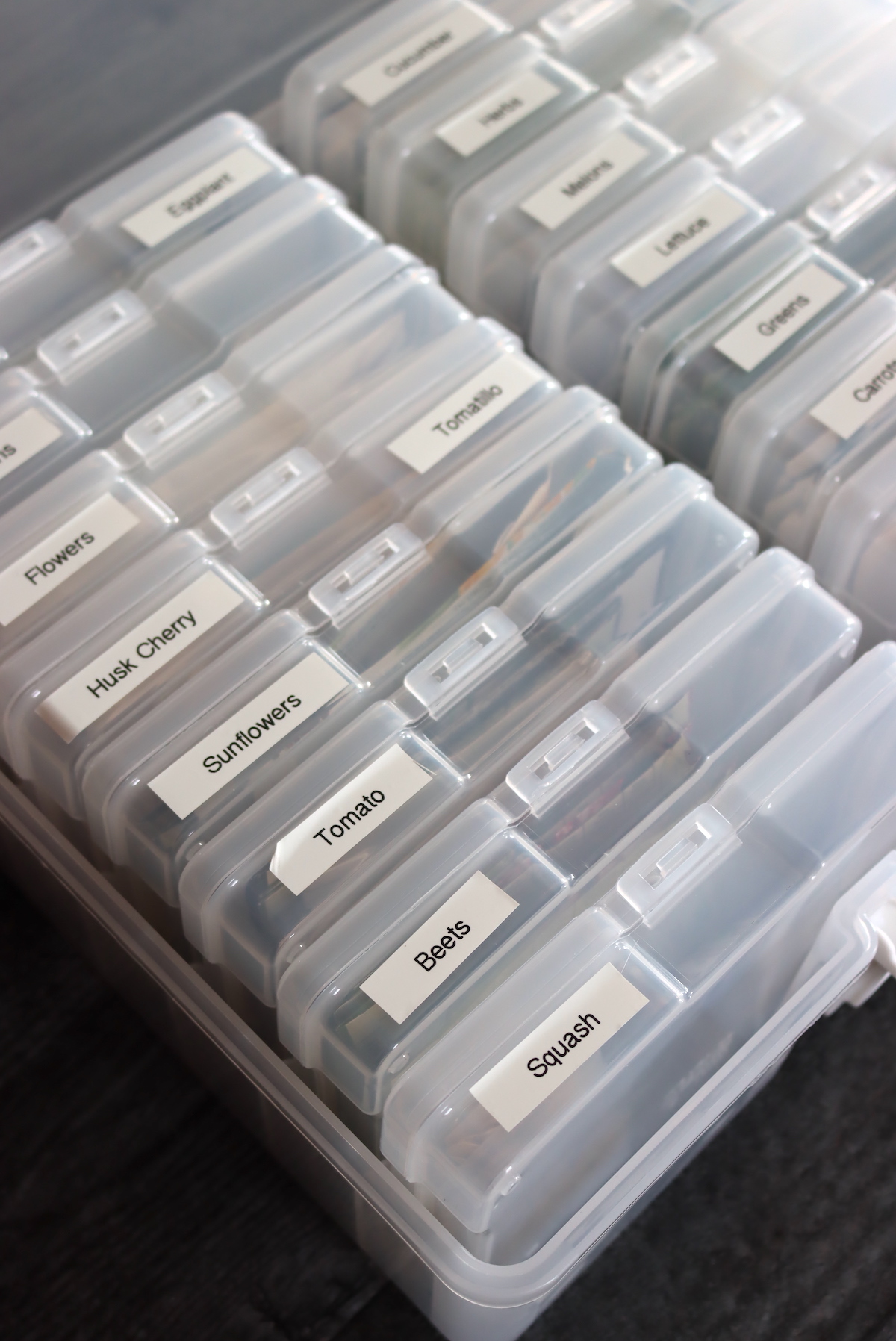
Not everyone will need a specific container for beets and carrots, and root crops together will probably suffice.
We happen to grow a lot of fresh beet greens and also use beets for canning, both as canned plain beets and pickled beets. We also can carrots and make pickled carrots, as well as eat fresh summer carrots all season long. We go through a lot of those seeds in our succession planting all summer long.
Likewise, we have our container for sunflowers, both because they’re my daughter’s favorite cut flower and because we grow sunflowers for edible seeds.
Obviously, you can choose your own labels based on your needs and your family’s preferences.
I particularly like that when I’m looking at the seed organizer, I can see roughly how many packets of each type I have without even opening it.
At a glance, I can look in and see that I’m running low on lettuce/greens seeds because there are only 1 or 2 packets in there (and we usually plant 8-10 varieties).
The clear containers really help keep me on track.
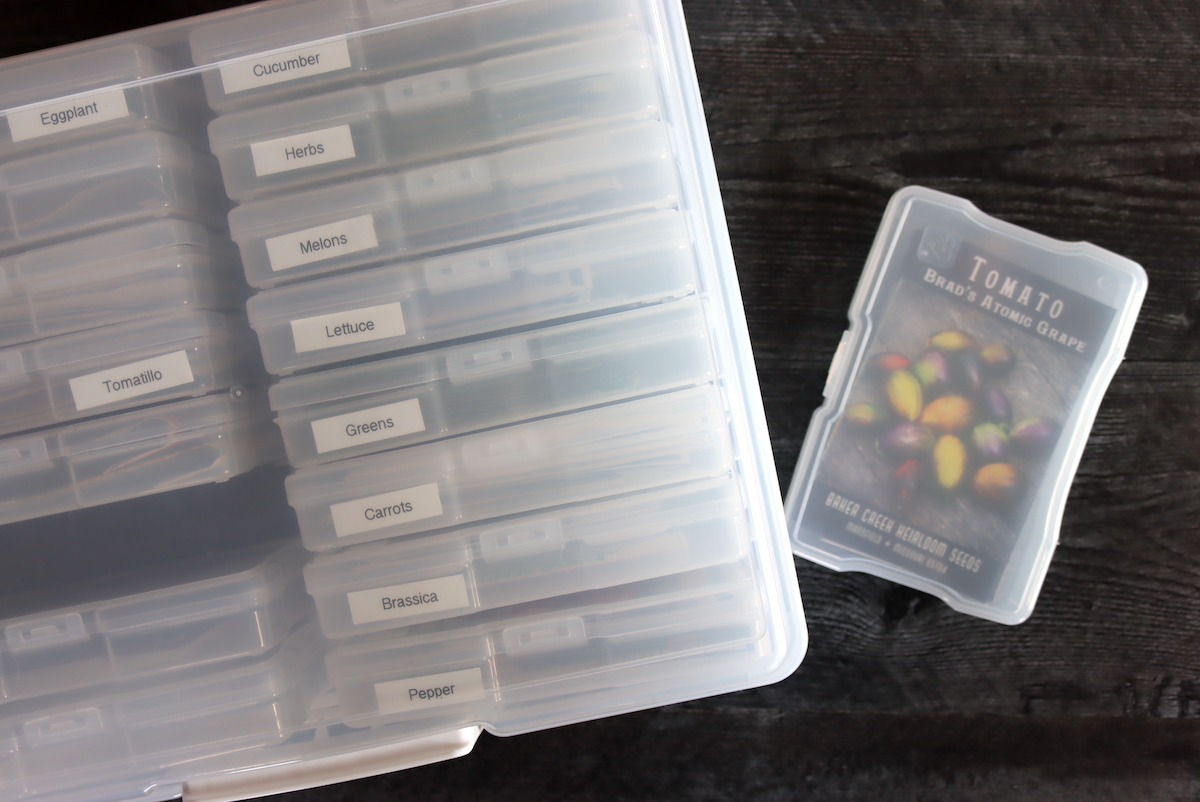
The whole container seals well to keep out moisture (though it’s obviously not waterproof, so don’t dunk it in the tub or leave it out in the rain).
But portability means I can take it out to the garden and set it down on a garden bed without worrying about the seeds getting ruined from the moisture in the soil. I’ve ruined seed packets all too often by setting them on the moist soil and then forgetting about them for a few hours.
It’s okay if you’re going to plant the whole packet that day, but it just won’t work if you’re planning on saving half the packet for later. Once they’re damp, they’ll mold if you don’t get them into the soil today.
In my seed organizer, they stay neat in their own compartments and protected from moisture in the garden too.
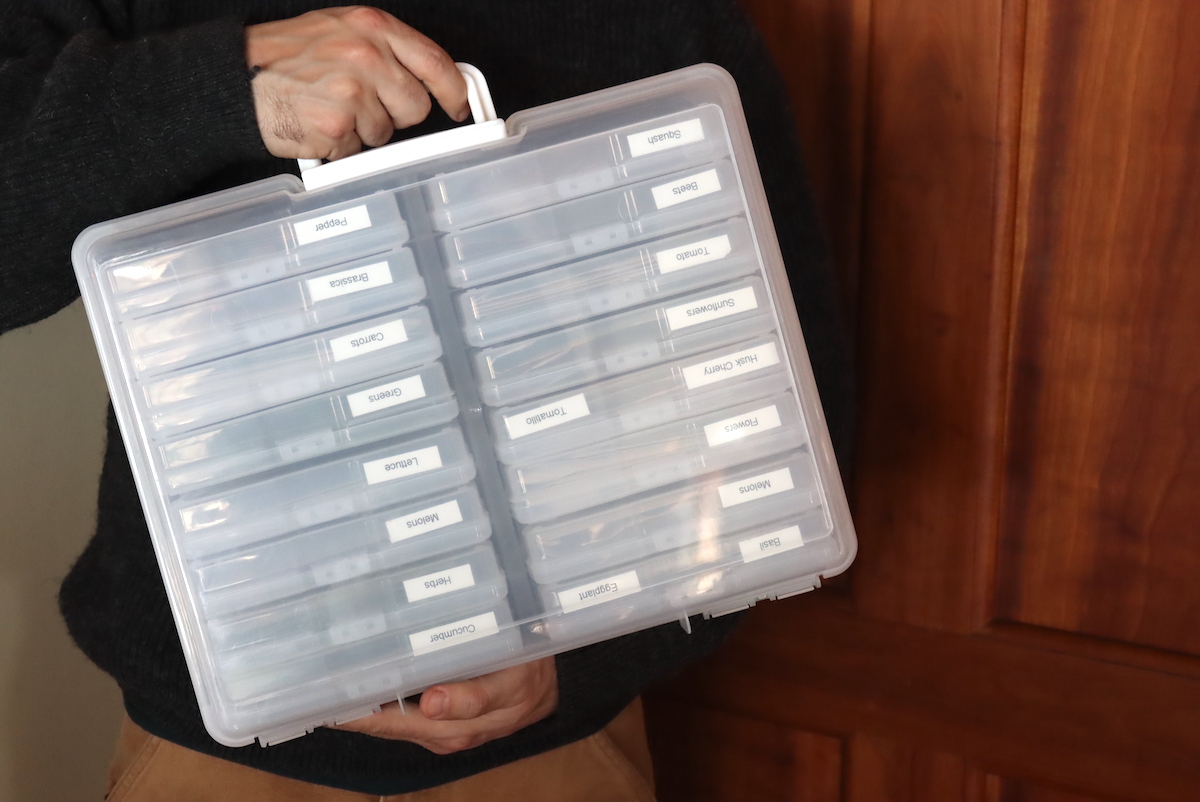
The only real downside is that seriously bulk quantities of seeds won’t fit. We order pea seed by the pound, both for fresh eating snap peas and canning peas. Those packets aren’t really “packets” in the proper sense. They’re more like quart to gallon envelopes of seed.
Anything we plant in mass will not fit.
In our case, that’s seeds for microgreens we grow in the winter, as well as some others like corn, beans, peas, and cilantro. We grow almost an actual lawn of cilantro each year for our favorite cilantro salsa (made with nothing but pureed cilantro, onions, and pickled peppers).
I keep most of our microgreen seed in a 5-gallon bucket, sealed with a gamma seal lid. It lives year-round next to our indoor seed starting rack with lights. Our seed starting rack is only used for starts for about 8 to 10 weeks in the late winter and early spring. The rest of the year, we’re growing microgreens, so we’ll actually go through a 5-gallon bucket of microgreen seed in a year, producing about a dozen different varieties.
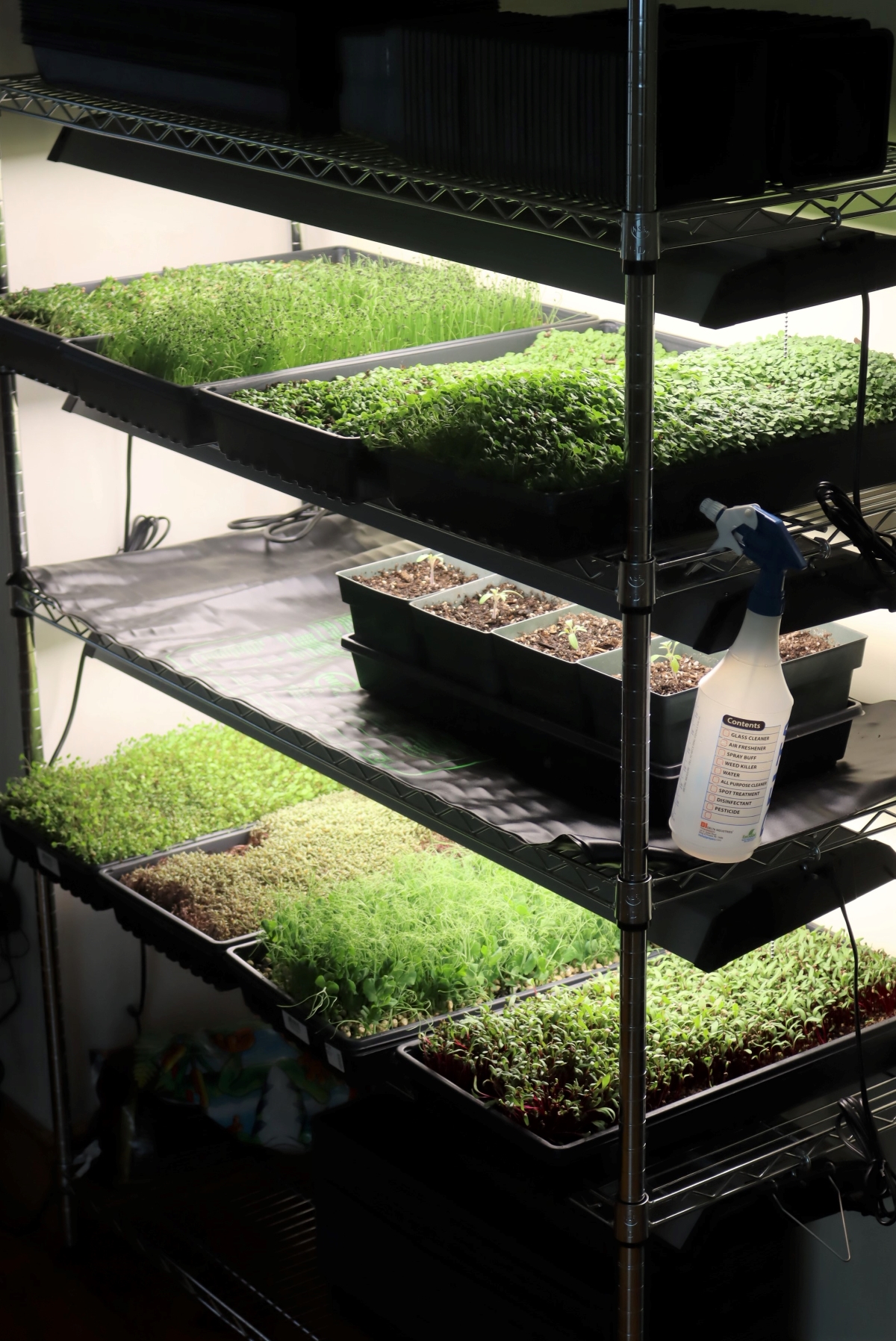
Beyond the microgreen seeds, I keep our “bulk” seeds in a separate shoebox-sized clear plastic tote. It’s just big enough to store all the overflow. Large seeded things (corn and beans) and bulk packets fit in there nicely.
For most people, who don’t grow a truly astronomical amount of microgreens, and who aren’t planting pea seed by the pound, a single photo organizer will easily hold all their seeds.
Each photo organizer pouch holds about 20 to 25 packets of tiny seeds (like tomato or lettuce seeds) or around 10 to 15 packets of larger seeds (like melons or squash).
(I know, some people, not naming names, have more than 25 packets of tomato seed…in that case, use two photo bins and separate them in some rational way, like cherry tomatoes in one, canning tomato varieties in another, and juicy heirlooms in the last one. Easy enough.)
Serious gardeners working more than an acre of land are likely going to need a second bulk bin as we keep, but for almost everyone else, a photo storage tote converted into a seed organizer is the perfect solution.
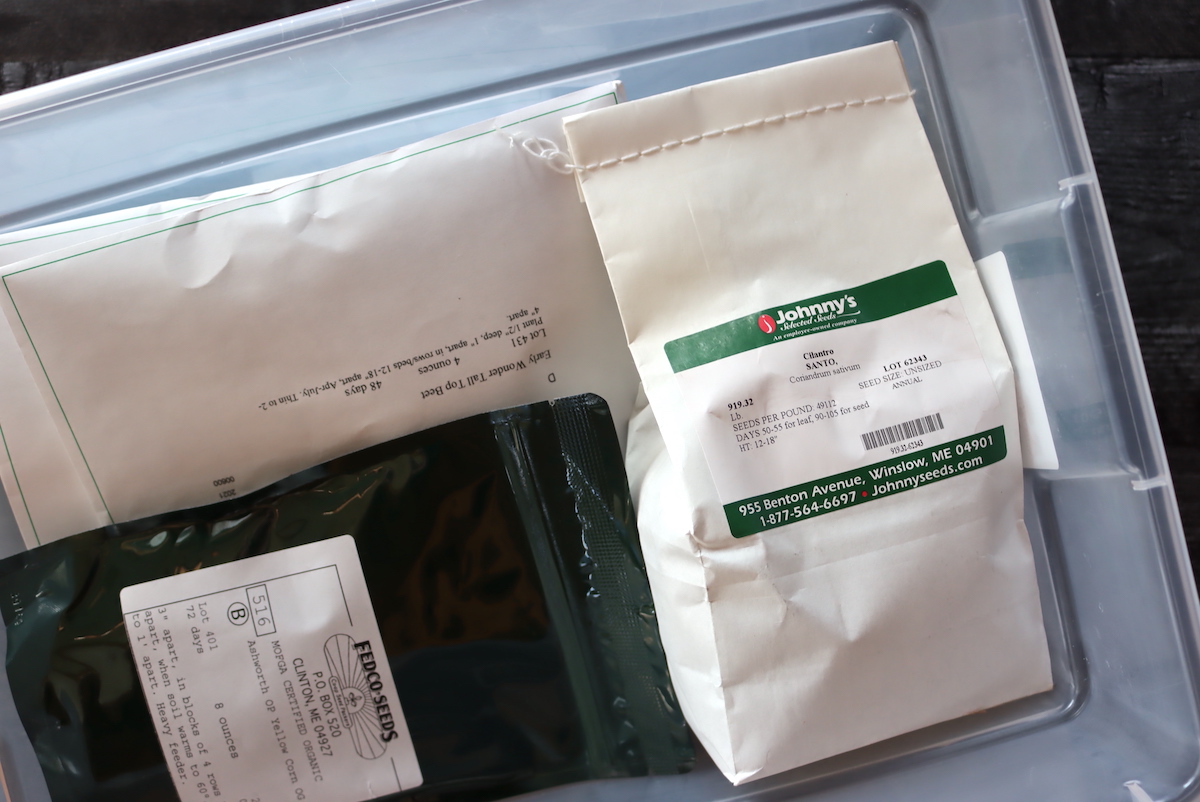
Best Place to Store Seeds
Now that your seeds are all neatly organized, where do you store your seed container?
We keep our seed organizer in the back of our pantry, which is just a dark closet on the north side of our house. It stays relatively cool all year long, and most importantly, it’s usually dry and not too humid. Our basement is humid enough for making cured meats like pancetta and our homemade cheddar cheese…that’s too humid for seed storage in general.
Ideal seed storage conditions are cool and relatively dry.
Some people choose to store their seeds in the refrigerator or freezer, but that’s not necessary with most seed types. It can actually be harmful in some cases, since moisture issues can be a problem depending on how they’re packaged. You may be dealing with condensation in the packets (from opening and closing the refrigerator or freezer), or the seeds may slowly dry out (like what happens when freezing fruit, vegetables, or meat…they get freezer burned).
I know, you’re going to tell me that the global seed vault is in the arctic and stores their seeds frozen…they also put their seeds through a special drying process first that dramatically reduces their moisture content. They have just enough moisture left to live, but not enough to spoil…and that’s a lot dryer than the average packet of seeds at home.
If you happen to be interested in super long-term storage of seeds as they do in the seed vault, the book The Resilient Gardener: Food Production and Self Reliance in Uncertain Times describes the process of preparing seeds for extended freezer storage in detail.
The best place to store your garden seed is somewhere with a consistently cool temperature and moderate to low humidity. That’s it, nothing special here. A closet or cool pantry works great.
(The exception to this is seeds that need cold stratification for germination, and those will actually need to be frozen or refrigerated for a few weeks or months before springtime so that they can break dormancy. That’s a particular case and not required for most garden seeds. Special medicinal herb seeds, some perennial fruits like sea berries, and some fruit trees, like apple tree seeds.)
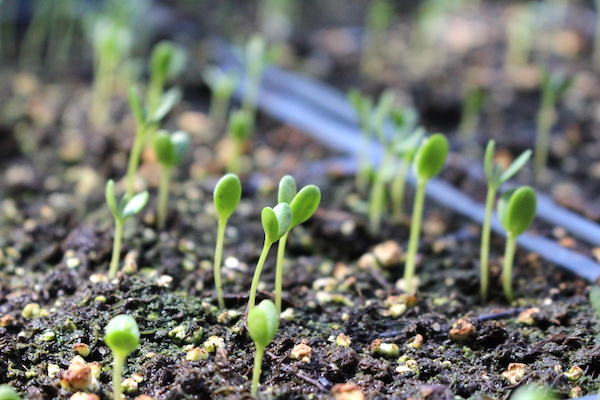
Growing From Seed Tutorials
Looking for advice on how to use your stored garden seed?
- Growing Strawberries from Seed
- Growing Asparagus from Seed
- Growing Rhubarb from Seed
- Growing Tomatoes from Seed
- Growing Garlic from Seed
- Growing Lemon Trees from Seed
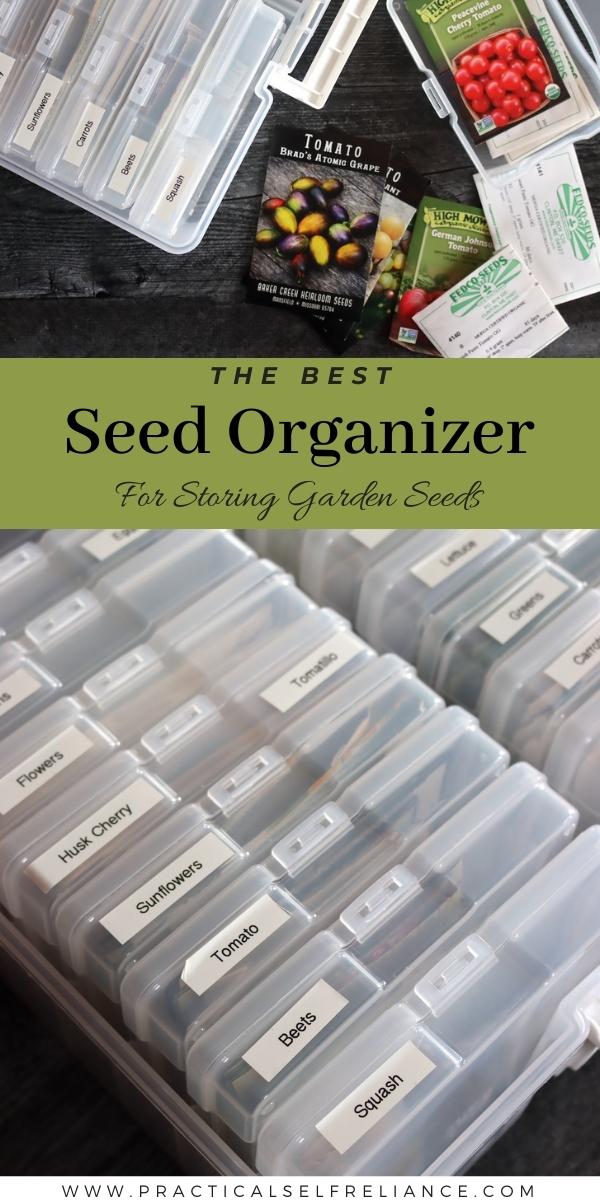

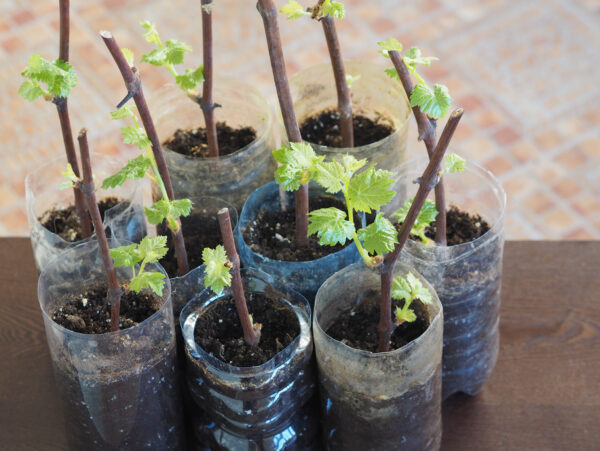
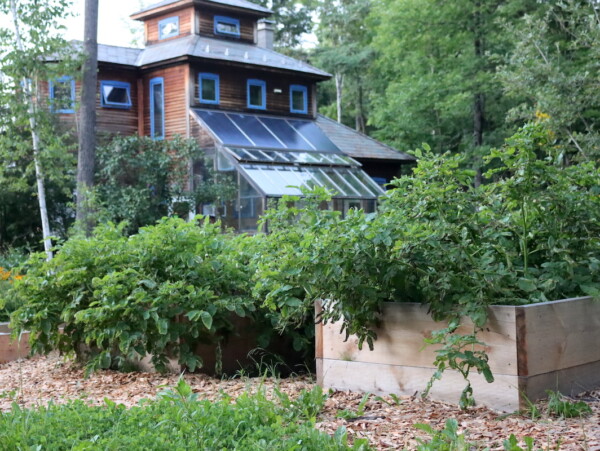
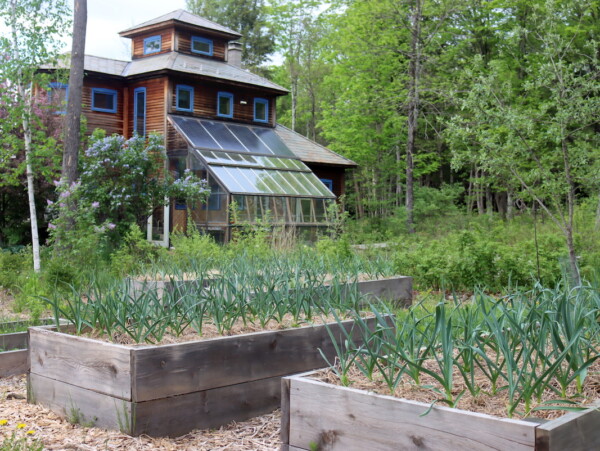










Ashley, you are a genius! : )
I’ve been using a hanging earring(?) sorter my mom gave me years ago which is great for the visual but not great for air tightness or grouping in categories! I super appreciate the link, may need a couple for all the different categories. Honestly when I saw your picture of already labeled bins, I was ready to buy it from you pre-labeled! (in case you’re considering a side hustle there could be a market for this LOL)
You are an inspiration in all you share here, thank you!
Too funny! Thanks so much. So glad it was helpful.
Excellent. I have this actual product for storing power cords to all the electronic devices. And the link to Etsy was inspiring. Just put another tote in my Amazon cart. Thank you Ashley.
P.
Perfect, so glad it’s helpful!
I love this idea and I am seriously thinking of giving it a try. Did you have any concern about the seeds being stored in plastic? I realize there will be a paper barrier between the seeds and the plastic. I’m asking because I try to avoid plastic when it pertains to storing food. Your thoughts?
I personally don’t have a concern with it in this particular application. I also think it’s worth it to protect the seeds from moisture which could potentially ruin them altogether.
After being talked into it on a Baker Creek fan page, I did get the photo album container for seed storage. Actually I’m on my third one, the wife stole the first two for old pictures she found – the nerve… The way I buy seeds, this set up works great for the current year. I buy three packs of everything I grow, so that if I need to trade off or give away – or use next season due to a lack of a particular seed, I have it. The leftovers, and the extra packets then go into what I call “deep storage” – a plastic ammo box that goes in the back of the pantry. Regular bulk seed packs fit in those as well, though they are still a pain for corn, beans and peas. I found that getting the seed to one end of a packet, then alternating the full ends on the packets works out pretty good.
Sounds like a great way to do it!